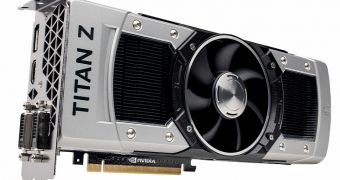The Pascal graphics processing unit may be the thing that NVIDIA and much of the world is looking forward to, but it's still pretty remote, set for a 2016 release, so the immediate attention is bound to go to the GeForce GTX Titan Z instead.
Since Advanced Micro Devices is preparing the Radeon R9 295X2 dual-GPU graphics card, it stood to reason that NVIDIA was working on one as well.
The Santa Clara, California-based company managed to beat AMD to the punch this time, having introduced the board at the GPU Technology Conference, yesterday (March 25).
Called GeForce GTX Titan Z, it has two GK110 graphics processing units working in concert on a black printed circuit board (PCB).
Thus, since each GK110 GPU has 2,880 CUDA cores, that puts the card as a whole at 5,760 cores, which is no small matter.
Also, to provide those two cores with the resources they need, NVIDIA installed 12 GB of GDDR5 VRAM (video random access memory) on the adapter.
There are two sets of 6 GB VRAM to be specific, linked to each of the two GPUs over interfaces of 384 bits, making for a total of 768 bits. The frequency of the memory is of 7 GHz.
That said, with two GPUs there are 480 texture mapping units (2 x 240 TMUs) and 96 ROPs (2 x 48 raster operating units).
As for the clock of the graphics processing units, we're afraid that it is still unknown. NVIDIA didn't specify it during the GTC keynote, and will probably withhold this last detail until next month.
We might not have to wait until the actual product release to learn it, if leaks come out before then, but at this point, we can only guess that the base speed, at least, is of around 700 MHz.
Sure, the GTX Titan Black reaches 889 MHz and 980 MHz boost, but that's with a single GPU and 6 GB VRAM.
On a dual-chip card, power and TDP limitations don't permit the GPU to work at the speed it otherwise would.
The price of NVIDIA's GeForce GTX Titan Z dual-GPU, triple-slot graphics card (a bulky single-fan cooler is employed) is of $3,000 / €3,000. It probably won't sell to even 1% of NVIDIA's customer base (this is usually the case with top-tier adapters, which are mostly for bragging rights anyway) and the company likely won't bother making too many, anticipating that.

 14 DAY TRIAL //
14 DAY TRIAL // 